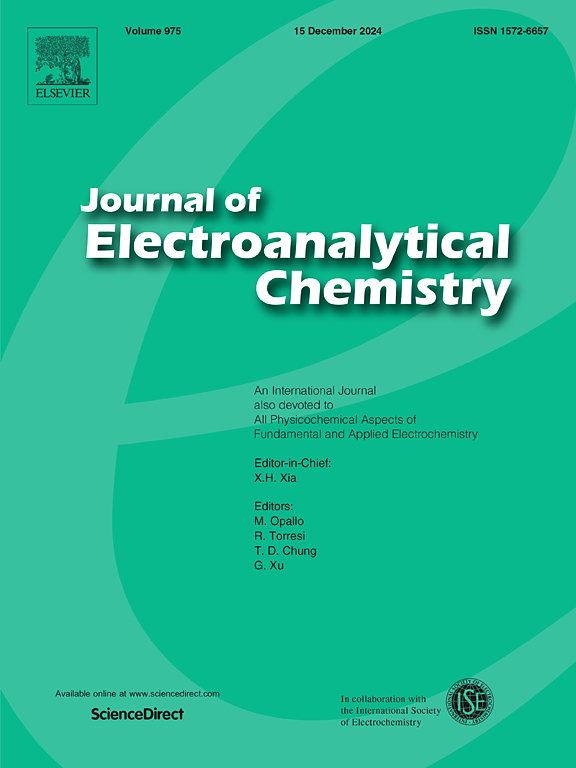低电位下同步双模电化学发光/电化学检测癌胚抗原
IF 4.1
3区 化学
Q1 CHEMISTRY, ANALYTICAL
引用次数: 0
摘要
近年来,人们采用电化学发光/电化学(ECL/EC)双模式检测策略,通过相互校正来提高检测精度。不幸的是,ECL和EC信号通常出现在两个相距很远的电位,导致不同的测试环境和不必要的副作用。为了解决这一问题,我们构建了一种双模ECL/EC aptsensor,实现了对癌胚抗原(CEA)在相同低电位下的ECL和EC的同步检测。CEA适体(Apt)首先被锚定在还原氧化石墨烯(rGO)上,通过静电和π-π堆叠相互作用促进了阳离子Hemin的后续吸附。吸附后的Hemin可以加速Ru(bpy)32+-Na2C2O4体系中溶解氧的电还原,不仅产生−0.2 V (vs. Ag/AgCl)的还原峰电流,而且产生大量羟基自由基(HO·)。HO·能将Ru(bpy)32+氧化为Ru(bpy)33+,然后由Ru(bpy)33与Na2C2O4反应产生ECL信号。因此,ECL和EC峰值信号在−0.2 V (vs. Ag/AgCl)时同步出现。当CEA存在时,它将Apt从电极上带走,减少Hemin的量,随后降低还原电流和ECL,在同一测试环境下实现同步双模检测。所获得的双模传感平台在临床应用中表现出良好的分析性能。本文章由计算机程序翻译,如有差异,请以英文原文为准。
A synchronous dual-mode electrochemiluminescence/electrochemical detection of carcinoembryonic antigen at low potential
Recently, dual-mode electrochemiluminescence/electrochemical (ECL/EC) detection strategies have been used for improving the detection accuracy by mutual correction. Unfortunately, the ECL and EC signals usually appeared at two far-apart potentials, resulting in different test environments and unnecessary side effects. To solve this problem, in this work, we constructed a dual-mode ECL/EC aptsensor, achieving the synchronous ECL and EC detections for the carcinoembryonic antigen (CEA) at the same low potential. The CEA aptamer (Apt) was firstly anchored on reduced graphene oxide (rGO), which promoted the subsequent adsorption of cationic Hemin through the electrostatic and π-π stacking interaction. The absorbed Hemin could accelerate the electro-reduction of dissolved oxygen in the air-saturated Ru(bpy)32+-Na2C2O4 system, generating not only a reduction peak current at −0.2 V (vs. Ag/AgCl) but also many hydroxyl radicals (HO‧). The HO‧ could oxidize the Ru(bpy)32+ to be Ru(bpy)33+, followed by the ECL signal produced by the reaction between Ru(bpy)33 and Na2C2O4. So, ECL and EC peak signals synchronously emerged at −0.2 V (vs. Ag/AgCl). When the CEA was present, it took the Apt away from electrode and decreased the amount of Hemin followed by the reduced reduction current and ECL, managing synchronous dual-mode detection in the same test environment. The obtained dual-mode sensing platform exhibited a good analytical performance in the clinical application.
求助全文
通过发布文献求助,成功后即可免费获取论文全文。
去求助
来源期刊
CiteScore
7.80
自引率
6.70%
发文量
912
审稿时长
2.4 months
期刊介绍:
The Journal of Electroanalytical Chemistry is the foremost international journal devoted to the interdisciplinary subject of electrochemistry in all its aspects, theoretical as well as applied.
Electrochemistry is a wide ranging area that is in a state of continuous evolution. Rather than compiling a long list of topics covered by the Journal, the editors would like to draw particular attention to the key issues of novelty, topicality and quality. Papers should present new and interesting electrochemical science in a way that is accessible to the reader. The presentation and discussion should be at a level that is consistent with the international status of the Journal. Reports describing the application of well-established techniques to problems that are essentially technical will not be accepted. Similarly, papers that report observations but fail to provide adequate interpretation will be rejected by the Editors. Papers dealing with technical electrochemistry should be submitted to other specialist journals unless the authors can show that their work provides substantially new insights into electrochemical processes.

 求助内容:
求助内容: 应助结果提醒方式:
应助结果提醒方式:


